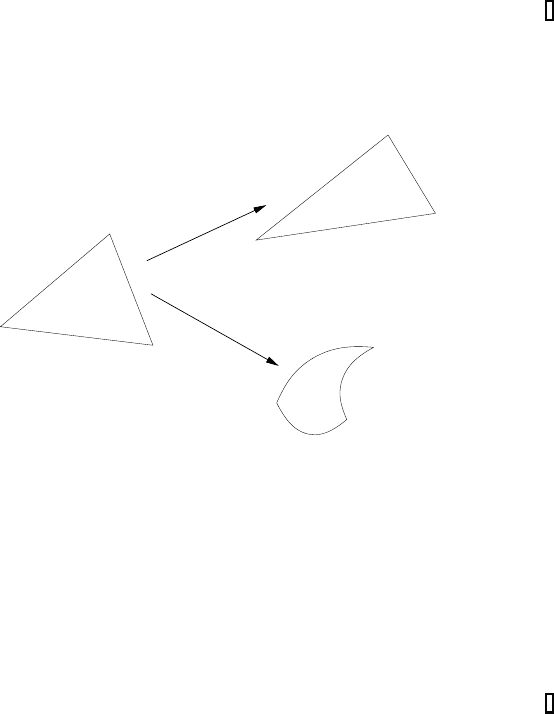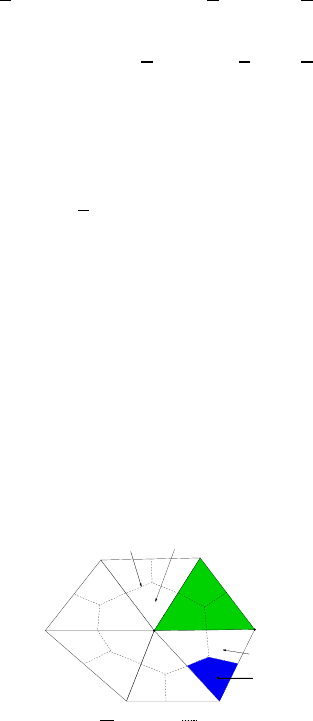Geiser J. Decomposition Methods for Differential Equations: Theory and Applications
Подождите немного. Документ загружается.


Discretization Methods 259
It is important to have the approximation of underlying integration.
Our problem is given as
∀u ∈ V, a(u, v)=f(v) , ∀v ∈ V, (B.138)
and the numerical approximation is given as:
∀u
h
∈ V
h
,a
h
(u
h
,v
h
)=f(v
h
), ∀v
h
∈ V
h
. (B.139)
We can deal with the following formulations of the elements :
1. Conforming elements: We have V
h
⊂ V and the bilinear form a
h
being
V
h
-elliptic.
2. Nonconforming elements: We have V
h
⊂ V and the bilinear form a
h
being V
h
-elliptic.
Estimation of the conforming and nonconforming elements is given in the
following lemma.
We have the general error estimation for the approximate operators and
functionals.
LEMMA B.5
There holds
||u − u
h
|| ≤ c inf
z
h
∈V
h
{||u − z
h
||+ ||f
h
− a
h
(z
h
, ·)||
∗,h
}.
REMARK B.17
• The choice of the nonconforming space Z is important to minimize the
error of the numerical approximation.
• V→ Z, the continuity is satisfied for the solution of the equation, while
the spaces are embedded in the space of the integration.
• V
h
→ Z
h
→ Z, also the discrete solution space is embedded into the
integration space.
Further, the approximation of the integration is given in the following
lemma.
LEMMA B.6
© 2009 by Taylor & Francis Group, LLC

260Decomposition Methods for Differential Equations Theory and Applications
First Lemma of Strang, see [186].
We have V
h
⊂ V and the bilinear form a
h
being V
h
-elliptic, then we have a
c>0 such that
||u − u
h
|| ≤ c inf
z
h
∈V
h
{||u −z
h
||+ ||a(z
h
, ·) − a
h
(z
h
, ·)||
∗,h
+||f −f
h
||
∗,h
} (B.140)
is fulfilled.
In the next subsection we present some examples of the elements.
B.3.4.8 Example: Conforming and Nonconforming Element for a
Plate Equation
Based on the embedding theorem,
W
j+m,p
(Ω) → C
j
(Ω
0
)ifmp > n, (B.141)
we need very high polynomial degrees for higher-order operators.
For example, look at the plate equation:
Δ
2
u = f inΩ , (B.142)
u = φ
1
,
∂u
∂n
= φ
2
on Γ. (B.143)
For a conforming element for one dimension, we need the first derivation, thus
the embedding should be in C
1
, such that for p =2wehavej =1andm =2
and so we have H
2
, which means we need third-order polynomials.
The element is given as w(x)=c
1
+ c
2
x + c
3
x
2
.
But for n = 2 we need H
3
and thus a 16-parameter element as minimum
(polynomial order 3).
A nonconforming element could be of a simpler reconstruction and we could
reduce the order, so we choose w(x)=c
1
+ c
2
x, and we are only in C
1
.
B.3.4.9 Extension to Isoparametric Elements and Curved
Domains
Here the idea of this discretization method is to obtain improved results at
the curved boundary.
The affine transformation from an element to this reference element is done
and this is added to the interpolation error.
We can formulate the following lemma.
LEMMA B.7
We have the following estimation of our interpolation error:
|v|
m,p,K
≤ c ||B||
m
|det(B)|
−1/p
|v|
m,p,K
}, (B.144)
© 2009 by Taylor & Francis Group, LLC

Discretization Methods 261
where x = Bx
+ b is the iso-parametric mapping.
The isoparametric mapping is presented in Figure B.4.
F (p)
2
affine case
K
K’
K’
F (p)
1
isoparametric case
FIGURE B.4: Isoparametric mapping.
REMARK B.18 Because of the mapping for the elements, the appli-
cation to the isoparametric elements is widespread in the engineering prob-
lems, see [20]. Mathematically, one can deal with the transformation and
treat the approximations with the unit element, see [46].
B.3.5 Finite Volume Methods
Finite volume methods are mostly applied in differential equations with
divergenceform, so, for example, parabolic differential equations with conser-
vation terms. One can see the theory of the finite volume methods with ideas
of the finite difference as also of the finite element methods. So the formu-
lation can be done as a generalized difference method or as a variant of the
finite element methods.
The fundamental works in this field are done for example in [113] and [121].
In the following we introduce the finite volume methods.
© 2009 by Taylor & Francis Group, LLC

262Decomposition Methods for Differential Equations Theory and Applications
B.3.5.1 Motivation to Finite Volume Methods
The finite volume method is aligned to the finite difference method for
unstructured grids.
Finite volume methods are also Petrov-Galerkin finite element methods.
Properties
• Conservativity: inner flux terms are added to be zero.
• Discretization of conservation laws and balance equations.
• Dual boxes allow simple discretizations.
• Theory of finite elements could be used for error estimates.
• Barycentric cells are needed for the barycentric method in R
n
.
Finite element methods are not conservative, which is a problem in nonlin-
ear and discontinuous parameters.
B.3.5.2 Model Equation: Convection-Diffusion Equation
We discuss in the following parabolic differential equation of second order.
We have for the linear elliptic equation the form
Lu := −∇ · (A∇u − vu)+ru = f, (B.145)
where A :Ω→ R
d,d
, v :Ω→ R
d
and r, f :Ω→ R.
The parabolic equation is given as
∂u
∂t
+ Lu = f, (B.146)
where we have the initial and boundary conditions given as
u(x, 0) = u
0
(x) ,x ∈ Ω , (B.147)
u(x, t)=
u(x, t) , (x, t) ∈ ∂Ω × (0,T), (B.148)
B.3.5.3 Formulation of the Finite Volume Method
In the following we present the formulation of the finite element method
and also finite volume method to see the differences.
First formulation (FEM formulation or Galerkin formulation), we have u ∈
H
1
0
(Ω),
Ω
∇v · A∇udx−
Ω
ub ·∇vdx +
Ω
cuvdx (B.149)
=
Ω
fv dx , ∀v ∈ H
1
0
(Ω).
© 2009 by Taylor & Francis Group, LLC

Discretization Methods 263
The second formulation is the Petrov-Galerkin method, which is the finite
volume formulation, we have u ∈ H
2
(Ω) ∩ H
1
0
(Ω),
B∈B
B
∇v(A∇u − bu)dx +
B
cuvdx −
∂B
vA∇udσ
(B.150)
+
B
buvdx =
Ω
fvdx , ∀v ∈ H
1
0
(B),
The idea is to have two different spaces, for example the primary and the dual
grid. For the dual grid we could choose a simpler space, for example, a box
space:
v =
$
1 ,x∈ B
0 , else
. (B.151)
The primary space could be chosen in a better space, for example, the P
1
or
P
2
space (Lagrange space) of the finite element methods.
Geometrical Construction of the Finite Volume Method
In the geometrical construction of the method, the underlying dual cells are
important. In the construction we have the local mass conservation, we obtain
simple test functions (box functions), and we can apply the construction to
unstructured grids (adaptive grids).
The first example is the standard first-order method based on the barycen-
tric meshes, see Figure B.5.
T
x
e
x
e ’
j j
x
x
j
k
l
l
Primary Grid Dual Grid
e
Ω
Ω
T
e
Γ
Γ
e
jk
FIGURE B.5: The primary and dual mesh of the finite volume method.
The construction is given with the T
e
elements, e =1,...,E number of
elements and the finite volume cells or dual cells Ω
j
, j =1,...,N number of
nodes. The dual cells are constructed by the barycentre of the elements and
the middle-point of each side. We obtain the tessellation of the dual cells, see
also Figure B.5.
A second example is a higher-order finite volume discretization by P
2
La-
grangian Elements, see Figure B.6.
© 2009 by Taylor & Francis Group, LLC

264Decomposition Methods for Differential Equations Theory and Applications
We have a finer discretization with the dual cells to obtain the conditions
for the P
2
elements. The trial space is given with P
2
elements, where the test
space is given with the constant P
0
elements, see [14].
T
x
k
Dreieckskante Duale Kante
x
e
x
e ’
j j
x
j
l
l
e
Γ
e
jk
Ω
Ω
T
e
Γ
FIGURE B.6: The primary and dual mesh of the higher-order finite vol-
ume method.
For the dual grid B, where the unknown solution u the nodes, we can
construct a first-order method as follows.
DEFINITION B.23 We have Ω ⊂ R
n
being a polyhedral Lips-
chitz domain and T
h
a consistent triangulation of Ω with the edge points
x
h
1
,...,x
h
N
h
.ThesetB
h
= {B
h
1
,...,B
h
N
h
} with the closed subsets B
h
j
⊂ Ωis
a dual box grid for T
h
, if we have the following conditions.
For the construction of the finite volume methods, we have to fulfill the
following conditions:
1. Regularity Conditions
DEFINITION B.24 We have Ω ⊂ R
n
being a polyhedral lips-
chitzian domain and T
h
a consistent triangulation of Ω. A dual box grid
B = {B
h
1
,...,B
h
N
h
} for T
h
fulfills the regularity condition, if
(R1) All box parts B
h
j
= T,1 ≤ j ≤ N
h
,T ∈T
h
are lipschitzian sets, cf.
(a set M ⊂ R
n
is a lipschitzian set, if int(M ) is a lipschitzian set
and
M = int(M)). B fulfills the second regularity condition (R2),
if
(R2) S
j,i
j
,T
(T ) ∩ S
i
j
,T
(T )=∅ is fulfilled for all 1 ≤ j ≤ N
h
and for all
elements T ∈T
h
j
.
2. Equilibrium Conditions
© 2009 by Taylor & Francis Group, LLC

Discretization Methods 265
DEFINITION B.25 We have Ω ⊂ R
n
being a polyhedral lips-
chitzian domain and T
h
a consistent triangulation of Ω. A dual box grid
B = {B
h
1
,...,B
h
N
h
} for T
h
fulfills the equilibrium condition, if
(G1)
vol(B
h
j
∩ T )=
vol(T )
n +1
. (B.152)
It fulfills the second equilibrium condition if we have for all boxes
B
h
j
∈B
h
an element T ∈T
h
j
and for all indices 0 ≤ k ≤ n with
k = i
j,T
the condition
(G2)
vol(S
j,k
(T )=vol(B
h
j
∩ S
k
(T )) =
vol(S
k
(T )
n
. (B.153)
In the following we can derive error estimates for the finite volume method.
Global Error Estimates
TheerrorestimateintheH
1
-norm is given by
THEOREM B.12
||u − u
h
||
1,2
≤
CM
0
α
(h
s
||u||
1+s,2
+ h||f ||
0,2
), (B.154)
whereby the constant C = C(Ω,δ,s) is independent from h, u, and f.
PROOF
We use the first Strang lemma and get the abstract error estimates.
Regularity for the Grid, Simplices
It is important for the hierarchical refinement that the conditions for the
finite volume methods have to be fulfilled.
Therefore, we have to deal with the consistent refinement that is introduced
in the following.
Topology of the simplices: T ⊂ R
n
,
vol T
n
=
1
n!
. (B.155)
Bases of simplices:
χ
Π(K)
=
N
j=k
λ
j
, (B.156)
© 2009 by Taylor & Francis Group, LLC

266Decomposition Methods for Differential Equations Theory and Applications
A consistent triangulation is given with the Kuhn-Theorem, see [25].
The regular or irregular refinement is given as follows:
1) Regular refinement: 2
n
simplices for each refinement, see Figure B.7.
n=2n=1
n=3
FIGURE B.7: Regular refinement of simplices.
2) Irregular refinement: less than 2
n
: For this case we have to use the ideas
of Brower’s fixed point theorem. Therefore, a hierarchical refinement is
possible and the application of multigrid methods is possible.
B.3.5.4 Higher-Order Finite Volume Methods: Reconstruction Method
and Embedding Methods
We discuss an improved second-order discretization method for the linear
second-order parabolic equation by combining analytical and numerical solu-
tions. Such methods are first discussed as Godunov’s scheme, see [110] and
[150], and use analytical solutions to solve the one-dimensional convection-
reaction equation. We can generalize the second-order methods for discon-
tinuous solutions because of the analytical test functions. One-dimensional
solutions are used in the higher-dimensional solution of the numerical method.
The method is based on the flux-based characteristic methods and is an
attractive alternative to the classical higher-order TVD-methods, see [119].
The analytical solution can be derived by using the Laplace transformation
to reduce the equation to an ordinary differential equation. With general
initial conditions (e.g., spline functions), the Laplace transformation is ac-
complished with the help of numerical methods. The proposed discretization
method skips the classical error between the convection and reaction equation
by using the operator-splitting method.
Embedding of Analytical Methods in Various Discretization
Methods In this section we focus more on the mixing of the methods de-
scribed in the first chapters. The overview for the different methods is given
and the coupling between the methods is done.
© 2009 by Taylor & Francis Group, LLC
Discretization Methods 267
The basic discretization methods as finite element, finite volume methods
are done with polynomial spaces. These spaces could fit with results for
smooth solutions, but a mixing for changes in the type of the equations is
often problematic. For these problems, numerical artifacts are known as os-
cillations, numerical diffusion, and so forth, and are described in [119] and
[143], especially for conservation laws.
The improvement for this new result came from the idea to stabilize the
polynomial base functions.
In this section we discuss the embedding of analytical solutions for a convection-
diffusion-reaction equation.
The analytical results for one, two, and three dimensions for linear convection-
diffusion-reaction equations are derived in [62], [84], [106], and [129].
In the following, we present the embedded reaction equation to the convec-
tion equation.
Improved Discretization Methods via Exact Transport and Reac-
tion on the Characteristics
The scalar equation is given by
∂
t
Rc+ ∇·v c =0.0, (B.157)
where the initial conditions are c(x, t
0
)=c
0
(x).
The spatial integration plus the theorem of Gauss for the derivatives give
Ω
j
∂
t
(Rc) dx = −
Ω
j
∇·(v c) dx = −
Γ
j
n · (v c) dγ, (B.158)
where Ω
j
is the j-th cell and v
jk
= n
jk
·
Γ
jk
v(γ) dγ.
|Ω
j
|(R(c
n+1
j
) − R(c
n
j
)) = −τ
n
k∈out(j)
v
jk
˜c
n
jk
+ τ
n
l∈in(j)
v
lj
˜c
n
lj
. (B.159)
The discretization scheme with the mass notation is
m
n+1
j
− m
n
j
= −
k∈out(j)
m
n
jk
+
l∈in(j)
m
n
lj
, (B.160)
with
m
n
j
= V
j
Rc
j
(t
n
) ,m
n
jk
= τ ˜c
n
jk
v
jk
, (B.161)
with the limitation to satisfy the monotonicity (local min-max property).
We use the reconstruction of the linear test function:
c
n
jk
= c
n
j
+ ∇c
n
j
(x
jk
− x
j
). (B.162)
© 2009 by Taylor & Francis Group, LLC

268Decomposition Methods for Differential Equations Theory and Applications
Limiters (slope and flux limiter):
min
k∈in(i)
{c
n
i
,c
n
k
}≤c
n
jk
≤ max
k∈in(i)
{c
n
i
,c
n
k
} ,j∈ out(i) , (B.163)
with limited value ˆc
n
jk
,
˜c
n
jk
=ˆc
n
jk
+
τ
τ
j
(c
n
j
− ˆc
n
jk
) ,τ
j
=
V
j
v
j
, (B.164)
v
j
=
k∈out(j)
v
jk
,v
jk
= n
jk
·
Γ
jk
v(γ) dγ . (B.165)
Modified Discretization with Finite Volume Methods of Higher-
Order and Embedded Analytical Solutions
We now apply a Godunov’s method for the discretization. We reduce the
equation to a one-dimensional problem, solve the equation exactly, and trans-
form the one-dimensional mass to the multidimensional equation. Therefore,
we only get an error in the spatial approximation, as given for the higher-order
discretization, and hence we can skip the time splitting error.
The equation for the discretization is given by
∂
t
u
i
+ ∇·v
i
u
i
= −λ
i
u
i
+ λ
i−1
u
i−1
, (B.166)
i =1,...,m. (B.167)
The velocity vector v is divided by R
i
,andm is the number of concentrations.
The initial conditions are given by u
0
1
= u
1
(x, 0) , u
0
i
=0fori =2,...,m.
The boundary conditions are trivial conditions (i.e., u
i
=0fori =1,...,m).
We first calculate the maximal time-step for cell j and for concentration i
using the total outflow fluxes:
τ
i,j
=
V
j
R
i
v
j
, v
j
=
j∈out(i)
v
i,j
. (B.168)
We get the restricted time-step with the local time steps of cells and their
components:
τ
n
≤ min
i=1,...,m
j=1,...,I
τ
i,j
. (B.169)
The velocity of the discrete equation is given by
v
i,j
=
1
τ
i,j
. (B.170)
We calculate the analytical solution of the mass with Equation (B.160) with
m
n
ij,out
= m
i,out
(a, b, τ
n
,v
1j
,...,v
ij
,R
1
,...,R
i
,λ
1
,...,λ
i
) , (B.171)
m
n
ij,rest
= m
n
i,j
f(τ
n
,v
1j
,...,v
ij
,R
1
,...,R
i
,λ
1
,...,λ
i
) , (B.172)
© 2009 by Taylor & Francis Group, LLC
